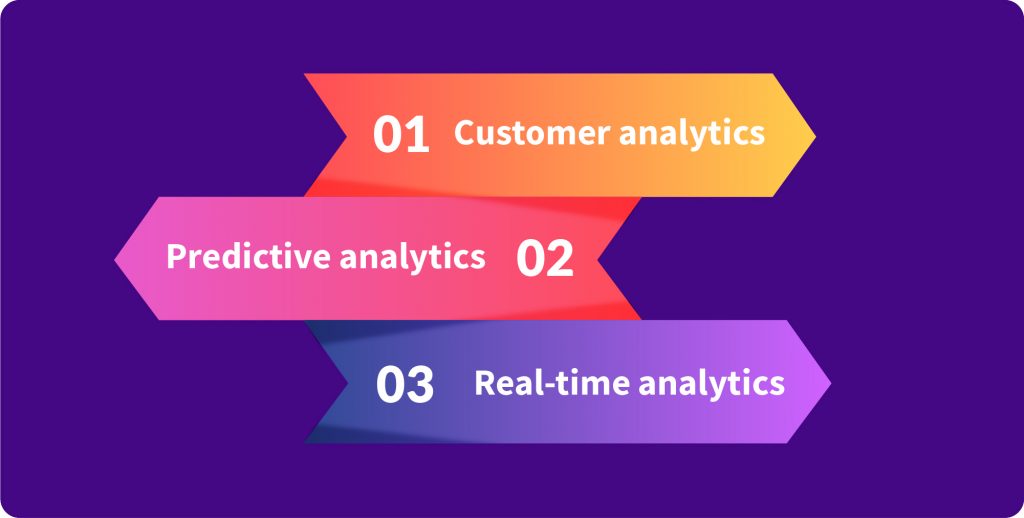Big Data is more than a buzzword. Data-driven optimization is the major objective of the financial industry, so many companies are looking for opportunities to utilize Big Data and make a great step forward to digital transformation. Big Data helps to discover competitive advantages and reveal new market opportunities.
written by:
Anastasia Borodinets
Big Data is more than a buzzword. Data-driven optimization is the major objective of the financial industry, so many companies are looking for opportunities to utilize Big Data and make a great step forward to digital transformation. Big Data helps to discover competitive advantages and reveal new market opportunities.
In this text, we are going to provide the true definition of Big Data, consider its possible usage cases in finance, and predict the challenges and disadvantages of its implementation.
The financial services industry is totally invaded by technology terms, like machine learning, artificial intelligence, the cloud, the Internet of Things (IoT), and Big Data, of course.
What is Big Data?
In some cases, the term is misused, and even when used properly - it’s really hard to define. We see that Big Data is used in the three most common meanings:
However, the encompassing definition of “Big Data” is as follows: cutting-edge technologies and frameworks used to gather, structure, process and analyze massive and diverse sets of data.
At the same time, all the above-mentioned types of analytics are about more specific activities: they are used to find patterns or to bring business value.
For sure, the practical use of Big Data is receiving business-related insights instead of just obtaining data. It demonstrates why analytics is the most widely known, visible and valuable aspect for businesses.
What’s special about Big Data in Finance?
Financial organizations generate impressive amounts of data, making the financial services sector one of the most data-dependent in the global economy. At the same time, these organizations are just at the starting point of transforming extensive data sets into valuable insights. For example, banks own terabytes of customer profile data and transaction history: online payments, purchases of goods and services, deposits, withdrawals, geodata and a lot more. If you need more details, ScienceSoft specialists share their ideas on Big Data implementation: in the financial industry and beyond.
In the last 5-7 years, most of the banks started actively investing resources in data collection and processing technologies, but to many of them, data warehouses or Business Intelligence still doesn’t seem to be a must-have.
In the situation of increasing and shifting customer demands, banks must compete with each other and also with rapidly growing fintech companies, which are struggling to anticipate customer needs and improve their experience.
3 V’s of Big Data (even 4)
To understand the value of Big Data in the finance industry, we suggest starting from the 3 V’s:
Companies implement certain aspects of Big Data depending on the industry, the company’s own priorities and goals.
Volume is the ability of Big Data technologies to work with multiple Tbytes (1000 Gbytes) or even Pbytes (1000 Tbytes) of data. The expanding volume of financial market data makes this V-volume a priority. Investment banks, asset management companies and capital markets need to deal with transaction history data, a high volume of quotes, market, and customer data. For example, the New York Stock Exchange alone creates and stores over a Tbyte daily. The same applies to insurance and retirement firms - the require a huge amount of data for proper risk management.
Velocity defines the speed of data analysis or the speed of sending it to the storage. As we have already mentioned above, The New York Stock Exchange deals with 1 Tb of information on a daily basis: 3 years ago there were already almost 19 billion network connections, which means 2.5 connections per each person in the world. No wonder, velocity is a key thing about Big Data in corporate finance: effective and quick processing of trades and other transactions is a major advantage. Experts talk about 105 transactions per second and even more.
Variety characteristic means that Big Data applications and algorithms can deal with structured and unstructured data in a variety of formats and from different sources. For example, Big Data in corporate finance means that institutions proceed with reference data, market data, customer requests and more.
Some researchers add the 4th V - it stands for veracity.
Veracity helps to figure out how accurate and applicable is the data, what is important and what is not - and to set these two types of data clearly apart. Veracity helps to build a deeper understanding of data contextualization and make this data applicable.
Big Data Revolution in the Financial Industry
In the past decade, Big Data and customer analytics in finance revolutionized the market, which becomes obvious due to major tech innovations in the following areas:
- Sales and Marketing;
- Risk management;
- Employee monitoring;
- Market prediction models;
Sales and Marketing in Banks and Fintechs
Big Data analytics can help financial industry players increase the effectiveness of all their marketing initiatives: customer acquisition, re-engaging and activation and relationship management.
How Big Data promotes sales and marketing in financial organizations:
1) Effective and super-targeted marketing campaigns - for example, by prospects segmentation based on public info and insights about the сustomers, by personalization of advertising messages, monitoring social media for direct feedback or by work of opinion leaders and influential customers.
2) Successful customer activation, cross- and upselling opportunities - boosting sales to existing customers or maximizing the first sales opportunity. It is possible due to predictive analysis of demand, proactive offers (like next-best-offers after the first purchase), creating product bundles and applying dynamic pricing. Banks and fintechs can increase sales by notifications, call-backs or personalized pop-ups based on customer insights and current customer behavior.
For example, banks can show investment opportunities when customers receive higher income or offer credit lines (overdraft) when customers have less money left than planned in their personal finance management tool.
Also, Big Data enables banks to contact customers right on time: when the deposit term is expiring or when the customer visits a foreign country and wants to increase the credit limit. There is certain customer information that can help a lot in sales: for example, when customers change the address after the move or relocation or change the marital status.
3) Customer relationship management. Data analytics can transform the financial business by analyzing the history of transactions and inquiries from multiple channels, family-related, and career insights. Also, it helps identify high-value clients to offer them premium services, individual offers and reveal the best communications channels to reach them. Increasing the loyalty of existing customers is possible due to tailoring loyalty programs according to the payment сard use and financial habits.
For example, banks and fintechs can partner with retailers and service providers to offer their propositions by geo preferences.
Big Data also can help to reveal possible problems with customers and prevent their leaving. For example, complaints in social media, official complaints to customer service reps or cancellation of certain services can be signs of it.
Risk Management
As the markets become more interconnected, the financial risks increase. High-quality and - what’s even more important - real-time insights in customer habits and behavior help to alleviate financial risks. The most frequently used Big Data applications in risk management are fraud-prevention models and user behavior risk management. In this part of the article, we will talk about these two and some other ways of using Big Data to avoid risks associated with financial transactions.
- Preventing Fraud and Money Laundering
Big Data analysis in finance can control and significantly reduce fraudulent activity. Big Data can be used for identity, card or insurance fraud detection (and even prevention). There are fraud-detection engines that continuously monitor the systems and assess the risks in real-time. Suspicious actions trigger additional security measures, like another authentication step or restricted access. As far as card fraud detection is concerned, the engine can analyze the location, timing, amount of funds required for the transaction and more to identify possible fraudulent activity and prevent losses.
- Credit Management
Big Data creates more opportunities for financial organizations in the credit risk management by offering higher predictive potential, providing new data sources and improving the credit models for both corporate clients and individuals. Credit risk management uses customer insights - like transactions or public information (company public reports). The implementation of IoT data (car sensors, inventory sensors) drastically improved the management of credit collaterals.
- Operational risks
Big Data helps increase control and improve the knowledge about the interaction between the company and its customers: like getting detailed insights on the cashflow and the optimization of liquidity management.
- Management of Legal Risks
Big Data analytics helps gather information on legal cases, analyze the current legislation states of being and track amendments to avoid penalties.
More Examples of Data-Driven Products and Services in Banks and Fintech Companies
- About a decade ago, Big Data combined with IoT revolutionized the insurance market by introducing data collection technologies. They changed the approach to insurance risk management: for example, by now over 1M of customers agree to install black boxes in their cars to track their average driving speed, manner of braking and car damages or thefts.
- JPMorgan Chase implements Big Data helps to evaluate local economies and suggests reasonable real estate prices to prevent mortgage loans from going into foreclosure. They considered repossessed properties resulting from foreclosed mortgages in order to decrease repossession and sale by the bank. The same technology can be implemented in credit evaluation and for marketing purposes.
- Flexible and personalized services for fintechs and digital banks: for example, analysis of spending data (and saving data) for customized offers and discounts.
- There are data-driven engines for credit scores and loan decisions - including social network analysis, frequency of changing cell phone numbers and the rate of social interaction. When it comes to SME banking, today banks have predictive models, which help to outline the current business situation for each company and calculate a ‘safe’ amount of funds to be borrowed.
- For crop insurance software developers and data analysts provide long-term weather predictions.
- IoT can be used in trade finance to enable automatic execution of the contract due to supply chain sensors.
- Personal Financial Management (PFM) and Wealth Management use Big Data to identify risks, financial goals, and their attainability, and propose budget plans.
- For algorithmic trading, Big Data supplies the system with information on investment opportunities in less than a second.
- Big Data can support internal management decisions as well: for example, by collecting and analyzing customer feedback from different channels. It seems to be a lot more effective in terms of relevance and resources when compared to traditional surveying or focus group research.
Big Data Challenges in Finance
In addition to major challenges that are common for Big Data use in all industries, there are a couple of specific challenges related to financing:
- Data security, which is especially important for the financial industry. With the growth of threats, the rise of hackers, financial industry players need to mitigate risks using data governance measures.
- Regulatory requirements, for example, FRTB (the Fundamental Review of the Trading Book).
- Data quality, which means sorting data that has business value and providing real-time analytics tools for high-quality insights, which help launch tailored products, services and show targeted content.
- Data integration is also a challenge, while financial data derives from lots of sources like documents, emails, enterprise software, etc. The use of data integration tools can help facilitate storage and access to the data.
To sum it all up
Big Data is not going to slow down the pace when transforming the financial services industry. Structured and unstructured data provides customer insights, complex algorithms execute trades, automation of credit score calculation minimizes human error. These are just a couple of ideas to mark the development of the industry, which was changed due to the Big Data. If you know more about them, let us know in the comments!
Qulix Systems is a trusted technology partner for the financial industry. Contact us to discuss your project and get quotes.

Contacts
Feel free to get in touch with us! Use this contact form for an ASAP response.
Call us at +44 151 528 8015
E-mail us at request@qulix.com








